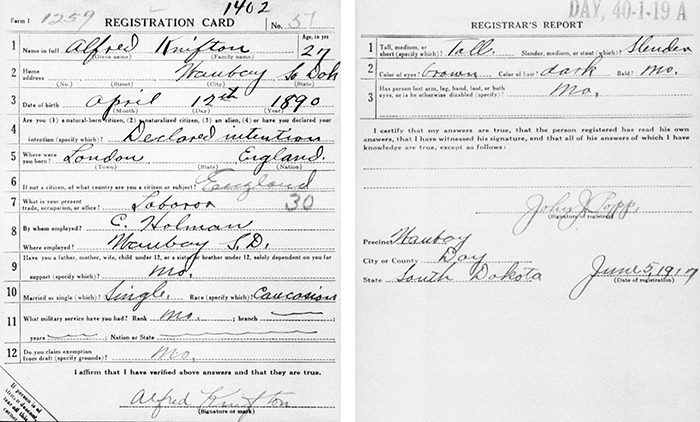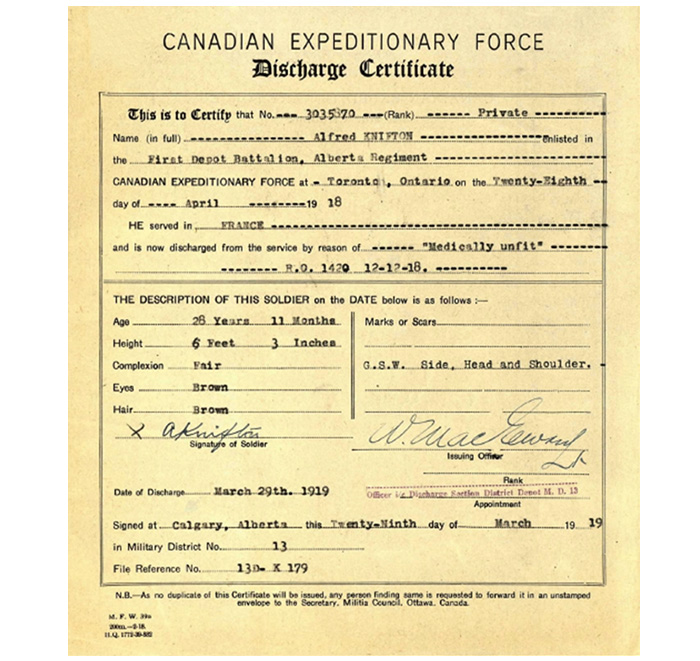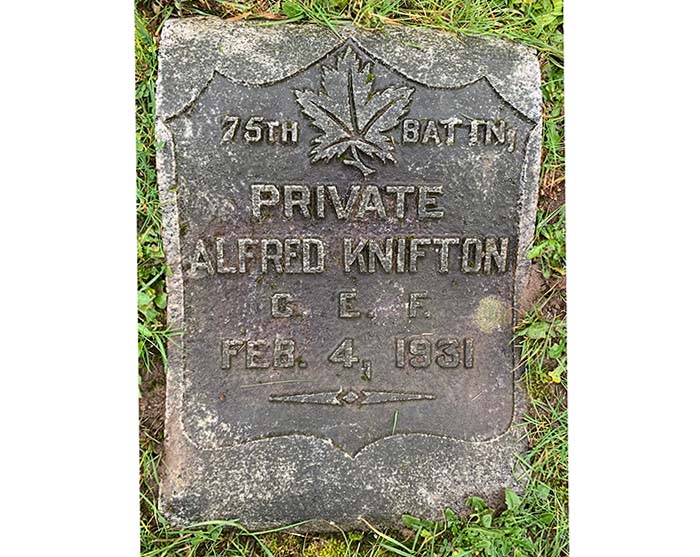


ALFRED KNIFTON 1890-1931
Private, Canadian Expeditionary Force
By Kevin Knifton 7th June 2023
Alfred was the tenth child of Jack and Ann Knifton. Born in Tottenham, London, 12th April 1890, Alfred moved with his family to 175 Burton Road, Clerkenwell before he was one year old. Within a month of his sixth birth, Alfred's father died at the age of 41. By 1901 the family had moved to 87 Listria Park, Stock Newington.
On 1st September 1906, Alfred boarded the SS Saint Paul at Southampton, and emigrated to the United States. He paid for the ticket himself, claimed to be a clerk, and carried $25 worth of cash. The ship arrived at Ellis Island, New York, on 8th September, where Alfred disembarked. At immigration he reported that he was travelling to visit his brother Arthur in San Pedro, California, but did not hold a ticket for this final destination. Alfred does not appear to have travelled that far west, but instead settled at Waubay in Say County, South Dakota, where he found work as a farm labourer.
Like his father, Alfred was a tall man, standing at 6 feet tall. He had brown eyes, dark hair, with a fair complexion, and by 1916 had a scar on his chin.
On 22nd March 1916, Alfred went to the Circuit Court of Say County and signed a Declaration of Intention. This was part of the procedure for him to apply for US citizenship, and Alfred signed his 'intention to renounce forever all allegiance and fidelity to any foreign prince, potentate, state, or sovereignty, and particularly to George V. King of Great Britain and Ireland, of which I am now a subject'.
Following the Selective Service Act which authorised the US President to temporarily increase the military power of the country, on 5th June 1917 Alfred, being between the age of 21 and 31, was included in the first of three registrations of men made during the First World War. Alfred was described as being tall and slender on the registration card.
 |
First World War US Draft Registration Card
Although living in the United States, Alfred signed up for the Canadian Overseas Expeditionary Force in Toronto, Canada, some 1,160 miles away from Waubay. He joined the 1st Depot Battalion of the 1st Canadian Overseas Regiment on 28th April 1918 with regimental number 3035870. His height was recorded as 6ft. 2¾in. (190cm.) and his chest measured 37 inches (94cm.). By this time he also had a scar on both shins and on his left hand. He stated that his religious denomination was Protestant, although on later records he claimed to be Church of England and Anglican. He directed that his pay and allowances be sent to his mother Ann in England: Alfred was paid 1 Canadian dollar per day plus a daily separation allowance of 10 cents.
After one month service in Canada, Alfred boarded the SS Cassandra troop ship in Canada on 3rd June 1918 as part of the 1st Depot Battalion, 1st C.O.R. The ship arrived on the North East coast of England almost three weeks later on 21st June. On arrival, Alfred was taken to Whitley Bay where he was transferred to the 12th Reserve Battalion and where he remained for three months. On 28th September 1918, Alfred was transferred to the 75th Battalion who were serving in France. He arrived in France on 30th September and after a few days joined his Battalion in the field.
France
Alfred's Battalion was in Quéant, West of Cambrai, when he joined it on 5th October: 'During the day a draft of 100 men arrived, having come direct from England and not through the reinforcement camp. They were a very good type of men, but not sufficiently trained. This is the largest draft we have had since last spring, and it will help fill up our depleted ranks.'1 The men in Alfred's Battalion had experienced heavy losses in September, and were now enjoying a short period of rest. They spent time training on Lewis Gunners, were re-equipped with new clothes, and practised baseball for inter-Company games. The Battalion comprised of Companies A, B, C, and D, although we do not know for certain, it appears that Alfred was in B Company. The Battalion was billeted 'in a sunken, with sufficient deep and comfortable dug-outs to house most of the men'1. The weather was wet, and at night enemy planes often flew overhead.
The 8th October was a cloudy and showery day, and at 8:45 p.m., Alfred with his Battalion were ready to board transport which would take them north-west to a point three miles south of Marœuil, near Arras. However, the buses were late and the men were 'moved to the side of the road, and spent several hours in cold night air...At midnight the Battalion were still at the side of the rod awaiting arrival of the convoy. The weather lately has become a good deal colder. Blankets are being issued as fast as possible. About half the Battalion has received an issue of one...At 3:00 a.m. the busses arrived, and the Battalion proceeded to the new camp, arriving there about 5:30 a.m.'1
At the new camp, the men continued with their training, which included 'Musketry, Lewis Gun and Rifle Grenade work'1. On 13th October, Alfred attended a Brigade Church Parade, which was held on the Engineers' Football field on the southern outskirts of Marœuil. 'The whole Brigade turned out very neat and smart...On account of the move forward the following day, and the necessity for giving some of the new men as much training as possible, specialist training was carried out in the afternoon.'1
The following day 'the Battalion, in full marching order, marched to Agnez-lés-Duisans, and there entrained at 10:00 a.m. The journey took a long time. We were held up for about two hours owing to an engine being off the track, but finally reached Marquion about 11:00 p.m. There the Battalion detrained, and commenced its march forward almost immediately. We reached our final destination, Écourt-Saint-Quentin, about 2:30 a.m. everybody feeling very tired....the companies were billeted in the houses in the village, which were very much more comfortable than the dug-out as the civilian population had evacuated the place leaving all the furniture and utensils there.'1
After a day of training, on 18th October the Battalion marched ten miles north-east to Bugnicourt, where they billeted; 'thus ended the first day of our chase of the Bosche, who was as usual retiring according to plan – prearranged – by the other side.'1 In the evening of 19th October, Alfred's Battalion marched through pouring rain to Auberchicourt, where 'everyone again had billets for the night, and most of us spent a very comfortable time. The men are now living like fighting cocks on the vegetables so kindly grown for us by brother Bosche.'1
In the morning of 20th October, the Battalion reached the village of Abscon, six miles east of Auberchicourt 'and here to our surprise we caught sight of women and children, the first we had seen in the conquered area. Poor people. They were dashed, and could not realise that they were now once more free people after four years of captivity.'1 From here the Battalion moved to Haveluy, and the Companies were sent to different places for several days, meeting up again on 30th October for training. Alfred's Battalion was visited by the Prince of Wales in the afternoon, who toured the billets, cook houses and transport lines. These days were described as very quiet: 'The war on our immediate front has now become static, and is for all the world like trench holding...the men live, even those on outpost duty along the canal, in houses which have not suffered much from gun fire.'1
On 31st October, Alfred left Haveluy, marching south to Denain and then north-east to Rouvignies, where they were in support of the 10th Brigade. While Alfred's Battalion was at full strength in terms of numbers, '80% of the men were practically untrained'1.
The next day, the Battalion marched to, and camped in, a field near Mont Houy, south of Valenciennes, but in the evening they were moved to the vicinity of Le Chemin Vert to support the 54th Battalion in an attack. On 2nd November, Company B and C took up positions on the front line, Company D was in support, and Company A in reserve. It was described as a very quiet night, which the Battalion spent at Aulnoy-lez-Valenciennes.
By 4th November, the 54th Battalion had taken the village of Marly and had advanced north-east towards Estreux, and Alfred's Battalion was ordered to pass through the 54th Battalion to secure a line east of Estreux. For this attack, Company B and C were again on the front line, Company D was in support, and Company A in reserve. By 3:00 p.m. Estreux was entirely cleared and the line was established 1,000 yards east of the village.
On 4th November 'it was expected that the Battalion would be relieved during the early hours of the morning, as each Battalion in the Brigade had done twenty-four hours show and had been leap-frogged by other Battalions. However, this was not our fortune and instructions were received from Brigade to continue the attack.1 The attack began at daybreak, with A Company passing through B Company, and D Company passing through C Company. 'All went well for the first 1,200 to 1,500 yards of the advance, little resistance being met on the left, but A Company suffered a few casualties from shell fire and also from machine gun nests which were hidden in a cemetery near the outskirts of the village of Rombies. They were also harassed by snipers from the houses.'1 The day ended with 'about' 40 casualties.
The Battalion was ordered to continue the attack on 5th November at daybreak, with B Company passing through A Company, and C Company passing through D Company. 'All went well for the first hour and a half. Rombies was practically evacuated the night previous and no resistance was felt by B Company, who had the western half of the village to take. When they got within 500 yards of the village of Marchipont they were held up by machine gun fire from the village...B Company, being held up from Marchipont, decided to make a frontal attack on it, so after obtaining five minutes artillery fire Major Popham sent out a platoon to endeavour to get into the village. This proved unsuccessful, and the result was a casualty list of 8 killed and 7 wounded.'1 Alfred was one of those wounded.
On 5th November Alfred suffered a gunshot wound. A bullet entered his body at the inferior angle of his left scapula, exited his left shoulder, and then pierced the lobe of his left ear. He was lucky to be alive. The next day he was admitted to the General Hospital at Dannes-Camiers, and on 8th November was moved to the Number 1 West General Hospital in Liverpool. Alfred had been in France for five weeks.
After spending almost three weeks in hospital at Liverpool, on 3rd December Alfred was transferred to the Canadian General Hospital at Basingstoke, where he stayed for two weeks. He was discharged on 18th December and returned to the 12th Reserve Battalion at Whitley Bay. However, he had a fractured scapular and the medical officer noted 'in disability - no Duty'.
On 16th January 1919 Alfred was at Kinmel Park in North Wales for an examination as part of his return to Canada. A form headed Medical Examination upon leaving the Service of an Officer fit for general service or a Soldier fit for duty was completed. He was 6ft. 2in. tall and weighed 160 lbs. (72.5kg). No issues were noted on the form, and the Medical Officer concluded that Alfred was 'good' in terms of health and physical condition. Three days later, on 19th January, Alfred was 'struck off service' from the 12th Reserve Battalion and transferred to the 1st Corps, district depot 13. He boarded the SS Scotian at Liverpool the same day, and arrived at the Port of Saint John near Halifax, Canada, on 1st March. On 7th March, Alfred was posted to 'Cas Co, Calgary' and was granted 'leave with sub to 21st March 1919'.
Back in Canada
For two years, Alfred had been suffering from a cough, which he described as sometimes being 'very bad'. Tuberculosis was suspected and Alfred visited a hospital on 18th March. After examining both of his lungs, the hospital reported 'Peririmchia infiltration of both lungs and Peripheral infiltration of right upper lobe which is suggestive of TB'. He was diagnosed with 'Tuberculosis (Pulmonary) Suspect'.
Two days later, on 20th March, the Medical Officer at Calgary in charge of Alfred's case completed a Medical History of an Invalid form. The information was provided by Alfred, who also signed the form. 'Operation scars right side of neck' were noted, although this was probably not a result of the gunshot wound since that was on his left side. The date and place which Alfred was infected with TB was reported as 'unknown'. Alfred was described as 'well developed and fairly well nourished and appears fairly healthy'. Details were provided regarding his breathing and breath sounds, which were described as 'slightly bronchial in character'. It was noted that Alfred had 'never coughed up any blood except after his wound' and that he 'says he tires easily'. The Medical Officer noted 'I think this man probably had TB before enlistment and that it has been aggravated to some extent by service.'. However, he also noted that at the time of enlistment, Alfred's medical condition was 'classified A.1.'.
The Medical Officer thought that Alfred's condition would probably last for '1 year under treatment' and that 'treatment in a sanatorium for a year' would likely be of material benefit. Also, in answer to Can the former trade or occupation be resumed? he wrote 'No. Condition would become aggravated without treatment'. The Medical Officer's recommendation was 'that he be placed in Category DIII and given treatment'. Category D meant 'temporarily unfit'.
Alfred's case then went to the Board of Medical Officers on 25th March. They concluded that Alfred would be placed in Category E, which meant he was unfit for service whether abroad or in Canada. In answer to Is it certified that the invalid does require treatment? they answered 'No'. In answer to It is recommended that the invalid be discharged? they answered 'Yes'.
Alfred was 'discharged from H.M. Service' on 29th March 1919. His Discharge Certificate notes that he had served in France but was 'now discharged from the service by reason of "medically unfit"'.
 |
Alfred was using a general mailing address in March 1919 so we do not know where he was living, but he was still in Calgary in June 1921, where he was lodging. He had been unemployed for over one year and was receiving income support from the government.
Between 1921 and 1931, Alfred moved to Vancouver, where he died on 4th February 1931. He was buried at Mountain View Cemetery: he was 40 years old. Stamped on the last page of his military record is 'Death attributable to Military Service.'
 |
75TH BATTN, PRIVATE ALFRED KNIFTON
C. E. F.
FEB. 4, 1931
1 War Diary of 75th Canadian Battalion - 4th Canadian Division, Volumes 27 and 28